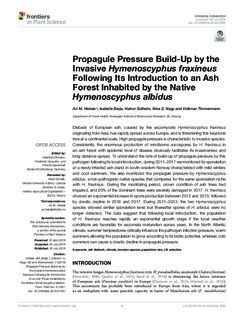| dc.contributor.author | Hietala, Ari Mikko | |
| dc.contributor.author | Børja, Isabella | |
| dc.contributor.author | Solheim, Halvor | |
| dc.contributor.author | Nagy, Nina Elisabeth | |
| dc.contributor.author | Timmermann, Volkmar | |
| dc.date.accessioned | 2018-08-06T12:14:21Z | |
| dc.date.available | 2018-08-06T12:14:21Z | |
| dc.date.created | 2018-07-31T13:03:05Z | |
| dc.date.issued | 2018-07-30 | |
| dc.identifier.citation | Hietala AM, Børja I, Solheim H, Nagy NE and Timmermann V (2018) Propagule Pressure Build-Up by the Invasive Hymenoscyphus fraxineus Following Its Introduction to an Ash Forest Inhabited by the Native Hymenoscyphus albidus. Front. Plant Sci. 9:1087 | nb_NO |
| dc.identifier.issn | 1664-462X | |
| dc.identifier.uri | http://hdl.handle.net/11250/2507635 | |
| dc.description.abstract | Dieback of European ash, caused by the ascomycete Hymenoscyphus fraxineus originating from Asia, has rapidly spread across Europe, and is threatening this keystone tree at a continental scale. High propagule pressure is characteristic to invasive species. Consistently, the enormous production of windborne ascospores by H. fraxineus in an ash forest with epidemic level of disease obviously facilitates its invasiveness and long distance spread. To understand the rate of build-up of propagule pressure by this pathogen following its local introduction, during 2011–2017 we monitored its sporulation at a newly infested ash stand in south-western Norway characterized with mild winters and cool summers. We also monitored the propagule pressure by Hymenoscyphus albidus, a non-pathogenic native species that competes for the same sporulation niche with H. fraxineus. During the monitoring period, crown condition of ash trees had impaired, and 20% of the dominant trees were severely damaged in 2017. H. fraxineus showed an exponential increase in spore production between 2012 and 2015, followed by drastic decline in 2016 and 2017. During 2011–2013, the two Hymenoscyphus species showed similar sporulation level, but thereafter spores of H. albidus were no longer detected. The data suggest that following local introduction, the population of H. fraxineus reaches rapidly an exponential growth stage if the local weather conditions are favorable for ascomata maturation across years. In the North Atlantic climate, summer temperatures critically influence the pathogen infection pressure, warm summers allowing the population to grow according to its biotic potential, whereas cold summers can cause a drastic decline in propagule pressure. | nb_NO |
| dc.language.iso | eng | nb_NO |
| dc.publisher | Frontiers Media S.A | nb_NO |
| dc.rights | Navngivelse 4.0 Internasjonal | * |
| dc.rights.uri | http://creativecommons.org/licenses/by/4.0/deed.no | * |
| dc.subject | ash dieback | nb_NO |
| dc.subject | climate | nb_NO |
| dc.subject | invasive species | nb_NO |
| dc.subject | population size | nb_NO |
| dc.subject | r/K selection | nb_NO |
| dc.title | Propagule pressure build-up by the invasive Hymenoscyphus fraxineus following its introduction to an ash forest inhabited by the native Hymenoscyphus albidus. | nb_NO |
| dc.type | Journal article | nb_NO |
| dc.type | Peer reviewed | nb_NO |
| dc.description.version | publishedVersion | nb_NO |
| dc.rights.holder | © 2018 Hietala, Børja, Solheim, Nagy and Timmermann | nb_NO |
| dc.source.volume | 9 | nb_NO |
| dc.source.journal | Frontiers in Plant Science | nb_NO |
| dc.identifier.doi | 10.3389/fpls.2018.01087 | |
| dc.identifier.cristin | 1599155 | |
| cristin.ispublished | true | |
| cristin.fulltext | original | |
| cristin.qualitycode | 1 | |

